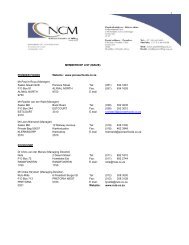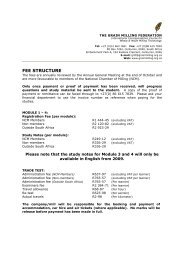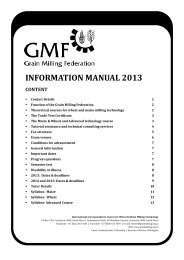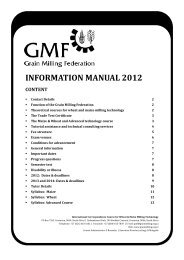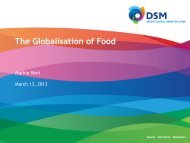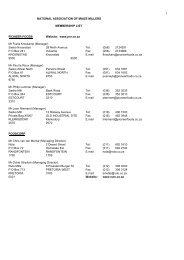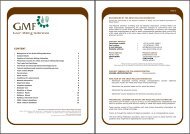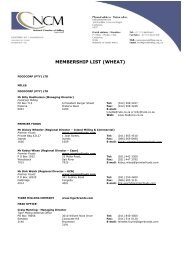(Sponsor) by Mr Bruno Kistner, Director of the Nutrition improvement
(Sponsor) by Mr Bruno Kistner, Director of the Nutrition improvement
(Sponsor) by Mr Bruno Kistner, Director of the Nutrition improvement
You also want an ePaper? Increase the reach of your titles
YUMPU automatically turns print PDFs into web optimized ePapers that Google loves.
Welcome to <strong>the</strong><br />
<strong>Nutrition</strong> Improvement Program<br />
1
The Global Pyramid<br />
Wealthy<br />
0.8 billion<br />
Malnourished:<br />
2 billion<br />
Emerging<br />
Middle Class<br />
1.5 billion<br />
Low Income Markets<br />
Base <strong>of</strong> Pyramid<br />
4 billion<br />
Hungry/starving:<br />
100 million<br />
(People who would<br />
not survive without<br />
aid = WFP target<br />
group)<br />
2
3<br />
Invisible
Malnutrition<br />
Malnutrition caused <strong>by</strong><br />
deficiencies <strong>of</strong> vitamins and<br />
minerals is also known as<br />
“hidden hunger”, because most<br />
<strong>of</strong> <strong>the</strong> people affected <strong>by</strong> it do<br />
not show <strong>the</strong> physical<br />
symptoms usually associated<br />
with hunger and malnutrition.<br />
4
What micronutrient deficiency causes in 12 months<br />
• 1 million children to die before <strong>the</strong> age <strong>of</strong> five<br />
• 50,000 women to die during or soon after childbirth<br />
• 19 million infants to be born with impaired mental capacity<br />
• 100,000 infants to be born with preventable physical defects<br />
• Global cost <strong>of</strong> malnutrition $19 billion in lost adult work<br />
performance and related health expenditure<br />
Source: GAIN<br />
5
Food fortification to fight malnutrition<br />
Food Fortification is <strong>the</strong> deliberate addition <strong>of</strong><br />
essential micronutrients into a food.<br />
Probably no o<strong>the</strong>r technology available today<br />
<strong>of</strong>fers as large an opportunity to improve lives<br />
and accelerate development at such low cost and<br />
in such a short time.<br />
Source: Enriching Lives, The World Bank<br />
6
Why staple food fortification<br />
• affordable<br />
• easy<br />
• effective<br />
• no change <strong>of</strong> staple food in color or<br />
taste.<br />
• no change in dietary habits<br />
7
Effective fortification is affordable,<br />
ineffective fortification is expensive.<br />
8
1. No compromise on effectiveness<br />
We have a very firm<br />
position that a food<br />
fortification program<br />
must have a multinutrient<br />
approach, because<br />
malnourished people do<br />
not lack single<br />
micronutrients.<br />
9
2. No compromise on quality<br />
Low quality micronutrients<br />
are not only deceiving <strong>the</strong><br />
customers.<br />
They deceive <strong>the</strong> most<br />
vulnerable,<br />
<strong>the</strong> malnourished.<br />
10
3. Monitoring<br />
Successful food fortification programs require regular<br />
monitoring <strong>by</strong> <strong>the</strong> authorities to ensure effectiveness.<br />
11
We are partners in <strong>the</strong> emerging global ‘hidden<br />
hunger domain’<br />
AIM, Amsterdam Initiative against Malnutrition<br />
Project Laserbeam<br />
12
13<br />
Africa
Africa: Some projects we support with technical and<br />
scientific know-how<br />
• Ghana: Flour fortification<br />
• Zambia: Maize meal fortification, sugar fortification<br />
• Sudan, Malawi, Zambia, Kenya, South Africa and Nigeria: Sugar<br />
fortification<br />
• Nigeria and Kenya: flour, edible oil and pasta fortification<br />
• Namibia, Mozambique and Kenya: Technical and scientific<br />
support <strong>of</strong> government to develop mandatory fortification<br />
programs<br />
14
Wheat flour fortification worldwide<br />
Wheat Flour Fortification<br />
Initiatives (3)<br />
Mandatory (29)<br />
Not enforced (2)<br />
Targeted (2)<br />
Voluntary (19)<br />
15
USA: Cereal fortification with niacin eliminated<br />
pellagra<br />
3500<br />
3000<br />
Number <strong>of</strong> deaths<br />
2500<br />
2000<br />
1500<br />
1000<br />
500<br />
0<br />
38 39 40 41 42 43 44 45 46 47 48 49 50 51 52 53<br />
Year<br />
D. Miller, 1955<br />
16
Venezuela: Fortification <strong>of</strong> wheat and corn flour<br />
reduces iron deficiency and anemia<br />
in children <strong>of</strong> lower socio-economic groups<br />
in children <strong>of</strong> lower socio-economic groups<br />
40<br />
37<br />
35<br />
30<br />
Cases in %<br />
25<br />
20<br />
15<br />
10<br />
15<br />
19<br />
10<br />
1992<br />
1994<br />
5<br />
0<br />
Iron deficiency<br />
Anemia<br />
M. layrisse et al. Am J Clin<br />
Nutr. 1996; 64:903-7.<br />
17
Costa Rica<br />
In Costa Rica, it is mandatory to fortify sugar with vitamin A;<br />
wheat and maize flours with vitamins B1, B2, niacin, iron and<br />
folic acid; rice with vitamins E, B1, B12, folic acid, niacin, zinc<br />
and selenium; and milk with vitamin A, folic acid and iron.<br />
The Ministry <strong>of</strong> Health <strong>of</strong> Costa Rica<br />
recently published <strong>the</strong> results <strong>of</strong> a<br />
survey on <strong>the</strong> effects <strong>of</strong> its measures<br />
to improve <strong>the</strong> nutritional status <strong>of</strong><br />
<strong>the</strong> population from 1996 to 2008.<br />
The rate <strong>of</strong> anemia among<br />
preschool children has dropped<br />
some 70 percent.<br />
18
Costa Rica, massive reduction <strong>of</strong> vitamin A deficiency<br />
in preschool children<br />
The survey showed that sugar and<br />
milk fortification has clearly helped<br />
reduce vitamin A deficiency in<br />
preschool children: 67.1 percent<br />
have normal levels <strong>of</strong> vitamin A, 30.1<br />
percent are marginally deficient and<br />
only 2.8 percent demonstrate a more<br />
severe deficiency. The effect <strong>of</strong><br />
fortification programs is reflected in a<br />
more than threefold reduction <strong>of</strong><br />
vitamin A deficiency from 1996 to<br />
2008/2009.<br />
10<br />
9<br />
8<br />
7<br />
6<br />
5<br />
4<br />
3<br />
2<br />
1<br />
0<br />
8.7%<br />
2.8%<br />
1996 2008/9<br />
19
South Africa<br />
Since 2003 <strong>the</strong> fortification <strong>of</strong> wheat flour<br />
and maize meal with essential<br />
micronutrients is mandatory.<br />
DSM‘s contribution was <strong>the</strong> management<br />
and continuous, intensive collaboration<br />
and cooperation with all <strong>the</strong> stakeholders<br />
over a 5-6 year period.<br />
20



